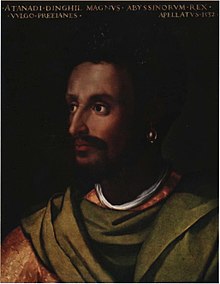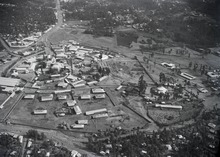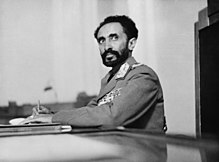Ethiopian Empire: Difference between revisions
m Dating maintenance tags: {{Npov}} |
Since there seems to be no objection Ive re-added the information on atrocities |
||
| Line 121: | Line 121: | ||
Beginning in the 1880s, under the reign of the Emperor [[Menelik II of Ethiopia|Menelik II]], the empire's forces set off from the central province of [[Shoa, Ethiopia|Shoa]] to incorporate through conquest inhabited lands to the west, east and south of its realm.<ref>{{cite journal |author=John Young |title=Regionalism and Democracy in Ethiopia |journal=Third World Quarterly |volume=19 |issue=2 |year=1998 |page=192 |jstor=3993156 |doi=10.1080/01436599814415}}</ref> The territories that were annexed included those of the western Oromo (non Shoan Oromo), Sidama, Gurage, Wolayta,<ref>International Crisis Group, "Ethnic Federalism and its Discontents". Issue 153 of ICG Africa report (4 September 2009) p. 2.</ref> and Dizi.<ref>{{cite journal|last1=Haberland|first1=Eike|title=An Amharic Manuscript on the Mythical History of the Adi kyaz (Dizi, South-West Ethiopia)|journal=Cambridge University Press on behalf of School of Oriental and African Studies|date=1983|volume=46|issue=2|page=240|url=http://docdro.id/LTiVtxU|accessdate=18 December 2017}}</ref> Among the imperial troops was [[Ras Gobena]]'s Shewan Oromo militia. Many of the lands that they annexed had never been under the empire's rule, with the newly incorporated territories resulting in the modern borders of Ethiopia.<ref>{{cite journal |title=Great Britain and Ethiopia 1897–1910: Competition for Empire |author=Edward C. Keefer |journal=International Journal of African Studies |volume=6 |issue=3 |year=1973 |page=470 |jstor=216612}}</ref> |
Beginning in the 1880s, under the reign of the Emperor [[Menelik II of Ethiopia|Menelik II]], the empire's forces set off from the central province of [[Shoa, Ethiopia|Shoa]] to incorporate through conquest inhabited lands to the west, east and south of its realm.<ref>{{cite journal |author=John Young |title=Regionalism and Democracy in Ethiopia |journal=Third World Quarterly |volume=19 |issue=2 |year=1998 |page=192 |jstor=3993156 |doi=10.1080/01436599814415}}</ref> The territories that were annexed included those of the western Oromo (non Shoan Oromo), Sidama, Gurage, Wolayta,<ref>International Crisis Group, "Ethnic Federalism and its Discontents". Issue 153 of ICG Africa report (4 September 2009) p. 2.</ref> and Dizi.<ref>{{cite journal|last1=Haberland|first1=Eike|title=An Amharic Manuscript on the Mythical History of the Adi kyaz (Dizi, South-West Ethiopia)|journal=Cambridge University Press on behalf of School of Oriental and African Studies|date=1983|volume=46|issue=2|page=240|url=http://docdro.id/LTiVtxU|accessdate=18 December 2017}}</ref> Among the imperial troops was [[Ras Gobena]]'s Shewan Oromo militia. Many of the lands that they annexed had never been under the empire's rule, with the newly incorporated territories resulting in the modern borders of Ethiopia.<ref>{{cite journal |title=Great Britain and Ethiopia 1897–1910: Competition for Empire |author=Edward C. Keefer |journal=International Journal of African Studies |volume=6 |issue=3 |year=1973 |page=470 |jstor=216612}}</ref> |
||
During the conquest of the Oromo, the Ethiopian Army carried mass atrocities against the Oromo population including mass mutilation, mass killings and large-scale slavery.<ref>Conquest, Tyranny, and Ethnocide against the Oromo: A Historical Assessment of Human Rights Conditions in Ethiopia, ca. 1880s–2002 by Mohammed Hassen, Northeast African Studies Volume 9, Number 3, 2002 (New Series)</ref><ref>Genocidal violence in the making of nation and state in Ethiopia by Mekuria Bulcha, African Sociological Review</ref><ref>Conquest, Tyranny, and Ethnocide against the Oromo: A Historical Assessment of Human Rights Conditions in Ethiopia, ca. 1880s–2002 by Mohammed Hassen, Northeast African Studies Volume 9, Number 3, 2002 (New Series)</ref> Some estimates for the number of people killed as a result of the conquest go into the millions.<ref>A. K. Bulatovich Ethiopia Through Russian Eyes: Country in Transition, 1896–1898, translated by Richard Seltzer, 2000</ref><ref>Conquest, Tyranny, and Ethnocide against the Oromo: A Historical Assessment of Human Rights Conditions in Ethiopia, ca. 1880s–2002 by Mohammed Hassen, Northeast African Studies Volume 9, Number 3, 2002 (New Series)</ref><ref>Power and Powerlessness in Contemporary Ethiopia by Alemayehu Kumsa, Charles University in Prague</ref> |
|||
Delegations from the United Kingdom and [[France]]{{snd}}European powers whose colonial possessions lay next to Ethiopia{{snd}}soon arrived in the Ethiopian capital to negotiate their own treaties with this newly-proven power. |
Delegations from the United Kingdom and [[France]]{{snd}}European powers whose colonial possessions lay next to Ethiopia{{snd}}soon arrived in the Ethiopian capital to negotiate their own treaties with this newly-proven power. |
||
Revision as of 02:38, 23 December 2017
Ethiopian Empire | |||||||||
|---|---|---|---|---|---|---|---|---|---|
| 1137–1974 1936-1941: Government-in-exile | |||||||||
| Motto: Ityopia tabetsih edewiha habe Igziabiher ኢትዮጵያ ታበፅዕ እደዊሃ ሃበ አግዚአብሐር "Ethiopia Stretches Her Hands unto God" | |||||||||
| Anthem: Ityopp'ya Hoy dess yibelish[1] ኢትዮጵያ ሆይ ደስ ይበልሽ "Ethiopia, Be happy" | |||||||||
 The Ethiopian Empire during the reign of Menelik II | |||||||||
| Capital | Unspecified (1137–1635) Gondar (1635–1855) Magdala (1855–1868) Mekele (1871–1885) Addis Ababa (1886–1974) | ||||||||
| Common languages | Ge'ez (official) Amharic, Afar, Gamo, Gedeo, Gurage, Hadiyya, Kafa, Oromo, Sidamo, Somali, Tigrinya, Wolaytta (widely spoken) | ||||||||
| Religion | Ethiopian Orthodox | ||||||||
| Government | Absolute monarchy[2] | ||||||||
| Emperor | |||||||||
• 1137 | Mara Takla Haymanot (first) | ||||||||
• 1930–1974 | Haile Selassie I (last) | ||||||||
| Prime Minister | |||||||||
• 1909–1927 | Habte Giyorgis (first) | ||||||||
• 1974 | Mikael Imru (last) | ||||||||
| Legislature | Parliament of the Ethiopian Empire[3] | ||||||||
| Senate | |||||||||
| Chamber of Deputies | |||||||||
| Historical era | Middle Ages to Cold War | ||||||||
• Empire established | 1137 | ||||||||
| 1895–1896 | |||||||||
| 23 October 1896 | |||||||||
| 16 July 1931 | |||||||||
| 3 October 1935 – May 1936 | |||||||||
• Sovereignty restored | 5 May 1941 | ||||||||
• Admitted to the United Nations | 13 November 1945 | ||||||||
• Coup d'état by Derg | 12 September 1974 | ||||||||
| 21 March 1975[4][5][6][7][8] | |||||||||
| Area | |||||||||
| 1950 | 1,221,900 km2 (471,800 sq mi) | ||||||||
| 1974 | 1,221,900 km2 (471,800 sq mi) | ||||||||
| Population | |||||||||
• 1950 | 19,575,000 | ||||||||
• 1974 | 35,074,000 | ||||||||
| Currency |
| ||||||||
| ISO 3166 code | ET | ||||||||
| |||||||||
| Today part of | |||||||||
The Ethiopian Empire (Amharic: የኢትዮጵያ ንጉሠ ነገሥት መንግሥተ, Mängəstä Ityop'p'ya), also known as Abyssinia (derived from the Arabic al-Habash),[9] was a kingdom that spanned a geographical area in the current state of Ethiopia. It existed from approximately 1137 (establishment of the Zagwe dynasty) until 1974, when the ruling Solomonic dynasty was overthrown in a coup d'état by the Derg.
Following the British occupation of Egypt in 1882, Ethiopia and Liberia were the only two African nations to remain independent during the Scramble for Africa by the European imperial powers in the late 19th century, though after the Second Italo-Ethiopian War, the Italian Empire established a short-lived colony in the region, which was overthrown in 1941. The country was one of the founding members of the United Nations in 1945.
In 1974 Ethiopia was one of only three countries in the world to have the title of Emperor for its head of state, together with Japan, which still has the Emperor as its nominal ruler, and Iran under the Pahlavi dynasty. It was the second-to-last country in Africa to use the title of Emperor; the only one later was the Central African Empire, which was implemented between 1976 and 1979 by Emperor Bokassa I.
History
D'mt and Kingdom of Aksum

Ethiopia's human occupation began early, as evidenced by the findings. It is believed that the ancient Egyptians claimed that Punt, known as gold country, was in Ethiopia in 980 BC. According to the Kebra Nagast, Menelik I founded the Ethiopian empire in the 1st century BC, around when the Axumite Empire was established. In the 4th century, under King Ezana of Axum, the kingdom adopted Christianity (Ethiopian Orthodox Church) as the state religion. It was thus one of the first Christian states.[10]
After the conquest of Aksum by Queen Gudit or Yodit, a period began which some scholars refer to as the Ethiopian Dark Ages.[11] According to Ethiopian tradition, she ruled over the remains of the Aksumite Empire for 40 years before transmitting the crown to her descendants.[11] Very little is known about the queen or the state, if indeed there even was one she set up. What is evident, however, is that her reign marked the end of Aksumite control in Ethiopia.
Zagwe dynasty
The last of Queen Yodit's successors were overthrown by Mara Takla Haymanot. He founded the Zagwe dynasty in 1137,[11] and married a female descendant of the last Aksumite emperor to stake his claim as the legitimate heir to the long dead empire.[11] The Zagwe kingdom's capital was at Adafa, not far from modern day Lalibela in the Lasta mountains.[12] The Zagwe continued the Orthodox Christianity of Aksum and constructed many rock-hewn churches such as the Church of Saint George in Lalibela. The dynasty would last until its overthrow by a new regime claiming descent from the old Aksumite kings.
Solomonic dynasty

In 1270, the Zagwe dynasty was overthrown by a king claiming lineage from the Aksumite kings and, hence, from Solomon.[12] The eponymously named Solomonic dynasty was founded and ruled by the Abyssinians, from whom Abyssinia gets its name. The Abyssinians reigned with only a few interruptions from 1270 until the late 20th century. This dynasty governed large parts of Ethiopia through much of its modern history. During this time, the empire conquered and annexed various kingdoms into its realm. The dynasty also successfully fought off Italian, Ottoman and Egyptian forces and made fruitful contacts with some European powers.
Adal Sultanate Invasion

In 1529, the Adal Sultanate's forces led by Ahmad ibn Ibrahim al-Ghazi invaded the Ethiopian Empire in what is known as the Abyssinian–Adal war. The Adal occupation lasted fourteen years. During the conflict, the Adal Sultanate employed cannons provided by the Ottoman Empire. In the aftermath of the war, Adal annexed Ethiopia, uniting it with territories in what is now Somalia. In 1543, with the help of the Portuguese Empire, the Solomonic dynasty was restored.
Princes Era

From 1769 to 1855, the Ethiopian empire passed through a period known as the "Princes Era" (in Amharic Zemene Mesafint). This was a period of Ethiopian history with numerous conflicts between the various ras (equivalent to the English dukes) and the emperor, who had only limited power and only dominated the area around the contemporary capital of Gondar. Both the development of society and culture stagnated in this period. Religious conflict, both within the Ethiopian Orthodox Church and between them and the Muslims were often used as a pretext for mutual strife. The Princes Era ended with the reign of the Emperor Tewodros II.
Reign of Emperor Tewodros II and scramble for Africa

In 1868, following the imprisonment of several missionaries and representatives of the British government, the British engaged in the punitive Expedition to Abyssinia. This campaign was a success for Britain and the Ethiopian emperor committed suicide.
The 1880s were marked by the Scramble for Africa. Italy, seeking a colonial presence in Africa, invaded Ethiopia and following a successful conquest of some coastal regions, forced the Treaty of Wuchale upon Shewa (an autonomous kingdom within the Ethiopian Empire), creating the colony of Eritrea.

Due to significant differences between the Italian and Amharic translations of the Treaty of Wuchale, Italy believed they had subsumed Ethiopia as a client state. Ethiopia repudiated the treaty in 1893. Insulted, Italy declared war on Ethiopia in 1895. The First Italo-Ethiopian War resulted in the 1896 Battle of Adwa, in which Italy was decisively defeated. As a result, the Treaty of Addis Ababa was signed in October, which strictly delineated the borders of Eritrea and forced Italy to recognize the independence of Ethiopia.
Beginning in the 1880s, under the reign of the Emperor Menelik II, the empire's forces set off from the central province of Shoa to incorporate through conquest inhabited lands to the west, east and south of its realm.[13] The territories that were annexed included those of the western Oromo (non Shoan Oromo), Sidama, Gurage, Wolayta,[14] and Dizi.[15] Among the imperial troops was Ras Gobena's Shewan Oromo militia. Many of the lands that they annexed had never been under the empire's rule, with the newly incorporated territories resulting in the modern borders of Ethiopia.[16]
During the conquest of the Oromo, the Ethiopian Army carried mass atrocities against the Oromo population including mass mutilation, mass killings and large-scale slavery.[17][18][19] Some estimates for the number of people killed as a result of the conquest go into the millions.[20][21][22]
Delegations from the United Kingdom and France – European powers whose colonial possessions lay next to Ethiopia – soon arrived in the Ethiopian capital to negotiate their own treaties with this newly-proven power.
Italian invasion and World War II

In 1935 Italian soldiers, commanded by Marshal Emilio De Bono, invaded Ethiopia in what is known as the Second Italo-Ethiopian War. The war lasted seven months before an Italian victory was declared. The invasion was condemned by the League of Nations, though not much was done to end the hostility.
During the conflict, Italy used sulfur mustard in chemical warfare, ignoring the Geneva Protocol that it had signed seven years earlier. The Italian military dropped mustard gas in bombs, sprayed it from airplanes and spread it in powdered form on the ground. 150,000 chemical casualties were reported, mostly from mustard gas. In the aftermath of the war Italy annexed Ethiopia, uniting it with Italy's other colonies in eastern Africa to form the new colony of Italian East Africa, and Victor Emmanuel III of Italy adopted the title "Emperor of Abyssinia".
On 10 June 1940, Italy declared war on the United Kingdom and France, as France was in the process of being conquered by Germany at the time and Benito Mussolini wished to expand Italy's colonial holdings. The Italian conquest of British Somaliland in August 1940 was successful, but the war turned against Italy afterward. Haile Selassie returned to Ethiopia from England to help rally the resistance. The British began their own invasion in January 1941 with the help of Ethiopian freedom fighters, and the last organized Italian resistance in Italian East Africa surrendered in November 1941, ending Italian rule.
Fall of monarchy

In 1974 a pro-Soviet Marxist–Leninist military junta, the "Derg", led by Mengistu Haile Mariam, deposed Haile Selassie and established a one-party communist state. Haile Selassie was imprisoned and died in unclear circumstances, a rumor being that he was suffocated with an ether-soaked pillow.[23]
See also
| History of Ethiopia |
|---|
 |
- Adal Sultanate
- Army of the Ethiopian Empire
- Crown Council of Ethiopia
- East African Campaign (World War II) (1941)
- Ethiopian Civil War (1974–1991)
- First Italo-Ethiopian War (1895–1896)
- History of Ethiopia
- Ethiopian historiography
- Italian East Africa (1936–1941)
- Italian guerrilla war in Ethiopia (1941–1943)
- List of Emperors of Ethiopia
- Second Italo-Ethiopian War (1935–1936)
- Sultanate of Ifat
- Sultanate of Showa
- Sultanate of Harar
- Zemene Mesafint (1755–1855)
References
- ^ "Ethiopia (1930-1975)". 16 January 2013. Retrieved 14 September 2016.
- ^ Nathaniel T. Kenney (1965). "Ethiopian Adventure". National Geographic. 127: 555.
- ^ Constitution of Ethiopia, 4 November 1955, Article 76 (source: Constitutions of Nations: Volume I, Africa by Amos Jenkins Peaslee)
- ^ "Ethiopia Ends 3,000 Year Monarchy". Milwaukee Sentinel. 22 March 1975. p. 3.
- ^ "Ethiopia ends old monarchy". The Day. 22 March 1975. p. 7.
- ^ Henc van Maarseveen; Ger van der Tang (1978). Written Constitutions: A Computerized Comparative Study. Brill. p. 47.
- ^ "Ethiopia". The World Factbook. Central Intelligence Agency. 1987.
- ^ "Ethiopia". Worldstatesmen.org.
- ^ E. A. Wallis Budge (1 August 2014). A History of Ethiopia: Volume I: Nubia and Abyssinia. Routledge. p. 7.
- ^ "Adejumobi, Seite 10"> Template:Mentions book
- ^ a b c d Adekumobi, p. 10
- ^ a b Pankhurst, p. 45
- ^ John Young (1998). "Regionalism and Democracy in Ethiopia". Third World Quarterly. 19 (2): 192. doi:10.1080/01436599814415. JSTOR 3993156.
- ^ International Crisis Group, "Ethnic Federalism and its Discontents". Issue 153 of ICG Africa report (4 September 2009) p. 2.
- ^ Haberland, Eike (1983). "An Amharic Manuscript on the Mythical History of the Adi kyaz (Dizi, South-West Ethiopia)". Cambridge University Press on behalf of School of Oriental and African Studies. 46 (2): 240. Retrieved 18 December 2017.
- ^ Edward C. Keefer (1973). "Great Britain and Ethiopia 1897–1910: Competition for Empire". International Journal of African Studies. 6 (3): 470. JSTOR 216612.
- ^ Conquest, Tyranny, and Ethnocide against the Oromo: A Historical Assessment of Human Rights Conditions in Ethiopia, ca. 1880s–2002 by Mohammed Hassen, Northeast African Studies Volume 9, Number 3, 2002 (New Series)
- ^ Genocidal violence in the making of nation and state in Ethiopia by Mekuria Bulcha, African Sociological Review
- ^ Conquest, Tyranny, and Ethnocide against the Oromo: A Historical Assessment of Human Rights Conditions in Ethiopia, ca. 1880s–2002 by Mohammed Hassen, Northeast African Studies Volume 9, Number 3, 2002 (New Series)
- ^ A. K. Bulatovich Ethiopia Through Russian Eyes: Country in Transition, 1896–1898, translated by Richard Seltzer, 2000
- ^ Conquest, Tyranny, and Ethnocide against the Oromo: A Historical Assessment of Human Rights Conditions in Ethiopia, ca. 1880s–2002 by Mohammed Hassen, Northeast African Studies Volume 9, Number 3, 2002 (New Series)
- ^ Power and Powerlessness in Contemporary Ethiopia by Alemayehu Kumsa, Charles University in Prague
- ^ [Jack, Ian (2001). Necessary Journeys. Granta. ISBN 978-1-929001-03-3.
{{cite book}}: Invalid|ref=harv(help), page 124
Bibliography
- Adekumobi, Saheed A. (2007). The History of Ethiopia. Westport: Greenwood Publishing Group. pp. 219 Pages. ISBN 0-313-32273-2.
- Pankhurst, Richard (2001). The Ethiopians: A History. Oxford: Blackwell Publishing. pp. 299 Pages. ISBN 0-631-22493-9.
- Shillington, Kevin (2004). Encyclopedia of African History, Vol. 1. London: Routledge. pp. 1912 Pages. ISBN 1-57958-245-1.
External links
 Texts on Wikisource:
Texts on Wikisource:
- "Abyssinia". Encyclopædia Britannica. Vol. 1 (11th ed.). 1911.
- "Ethiopia". Encyclopædia Britannica. Vol. 9 (11th ed.). 1911.
- "Abyssinia". Collier's New Encyclopedia. 1921.


